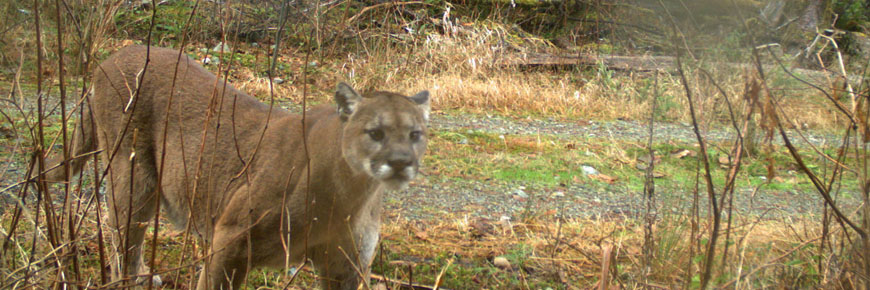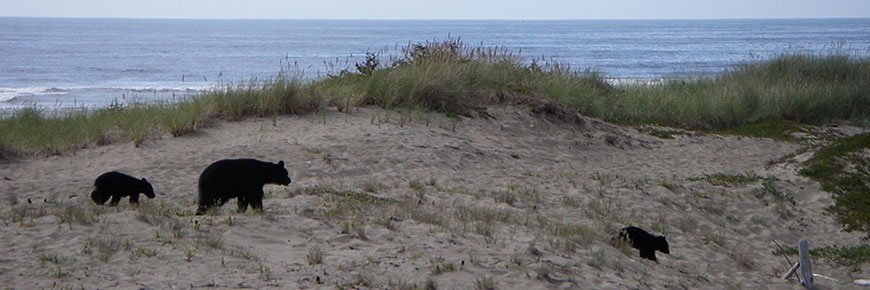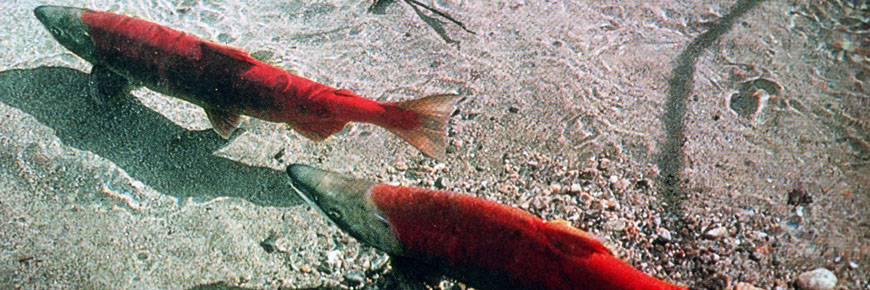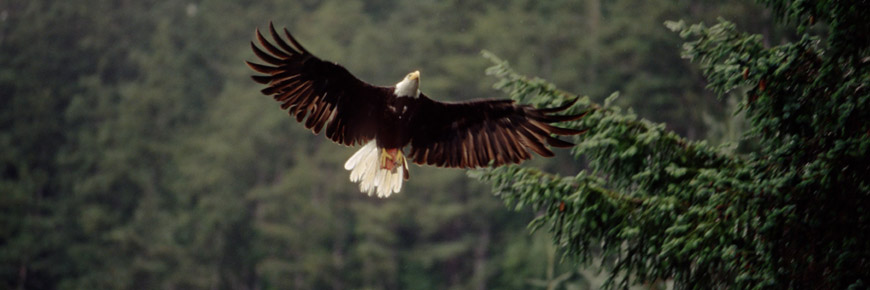Creature of the month
Find out which animals might be around when you visit.
Every month something different is happening in the national park reserve. Depending on when you visit some creatures will be more active than others.
Learn more about living with wildlife.
January – Wolves
Shy and elusive can be a good thing.

Wolves need space, and they like lots of it! A walk from Tofino to Ucluelet could be part of their normal day. In the winter, wolves often move closer to town to hunt prey such as deer, raccoons, and even pets. It’s important for wolves and people to maintain healthy boundaries around each other. If we get too close to them, life gets more dangerous for everyone involved.
February – Amphibians
Cool, wet, small, and hidden.

Frogs, toads, salamanders, and newts are amphibians. Even if you spend a long time looking for these creatures you may never find one. They hide well, so listen carefully. At this time of the year you may hear male frogs singing out to the females.
A healthy amphibian population is a sign of a healthy forest. Their skin is porous so pollutants that get into the waterways are quickly absorbed by amphibians.
Amphibians can also give us signs of our changing climate. Mating and egg laying happens about a month sooner than it did just a decade ago!
March – Grey Whales
Welcome back, grey whales!

Now is the perfect time to see 20,000 grey whales as they migrate from their winter breeding grounds near the Baja Peninsula in Mexico to their summer feeding grounds in the Bering and Chukchi Seas. Celebrate their return with the annual Pacific Rim Whale Festival. Participate in the festival activities, go on a whale watching tour, or head to the Kwisitis Visitor Centre viewing deck to spot the heart-shaped spouts of the whales as they pass by!
April – Bears
Bears are always around.

Vancouver Island has one of the densest populations of black bears in the world. Even if you don’t see one when you are here, you are likely in a bear’s territory. During winter, not all the bears sleep, and those that do sleep may wake up occasionally and go looking for a snack. Make sure you never let them eat human food, and know what to do if you see a bear.
May – Shorebirds
Tiny birds traveling incredible distances.

Some shorebirds come from South America, stay only days on our beaches, and then move on to the Arctic. For a journey like that they need to eat an incredible amount. Please give them lots of space. If they are not given space to forage for food they head onward up the coast without enough nourishment or rest, and are unable to reproduce. Join the Tofino Shorebird Festival to learn more and to celebrate this incredible migration.
June – Pinnipeds
Curious, playful, and not to be toyed with.

Seals and sea lions are two of the types of pinnipeds you might see in this national park reserve.Some people find seals and sea lions quite cute. It’s best to treat them like bears with flippers and stay a healthy distance away.
It’s never a good idea to let yourself or your pet approach them on the beach, on the rocks, or in the water. Learn more from our Marine Life page.
July – Bats
Small, shy, and only active at night.

Late July evenings are a good time to look for bats. Most bats are small, shy, and active only at night, so your best chance to see one is after the sun sets but the sky isn’t completely dark yet. Wait and watch. Even in the dark, bats use echolocation to navigate through the forest at high speed, chasing insects, without crashing into trees, or you. During the day, bats hide away under the bark of old trees, in caves, or in similar places where they can find darkness and shelter.
August – Cougars
Act big. Make Noise. Don’t run.

In the unlikely event that you see a cougar, never run. It’s a cat. If you run, it may run after you. Sometimes cougars are described as shy, but really they are such excellent hunters that they rarely let themselves be seen. Cougars generally avoid humans, but that’s not always the case. Be prepared by keeping your children and pets close to you. A cougar could be nearby at almost any time.
September – Bears
The get fat quick diet.
 Winter is coming! And for most bears that means it’s time to sleep. Local bears don’t usually sleep as long or as deeply as bears in places with more severe winters, because food here is available year-round. However, some bears will take long naps. This means that in the fall they turn into extreme eating machines. Their September diet plan is: get fat quick! This extreme focus on food is called hyperphagia. In this state, they can eat up to 20,000 calories daily. Don’t get between a bear and the food it wants, and never tempt it with human food!
Winter is coming! And for most bears that means it’s time to sleep. Local bears don’t usually sleep as long or as deeply as bears in places with more severe winters, because food here is available year-round. However, some bears will take long naps. This means that in the fall they turn into extreme eating machines. Their September diet plan is: get fat quick! This extreme focus on food is called hyperphagia. In this state, they can eat up to 20,000 calories daily. Don’t get between a bear and the food it wants, and never tempt it with human food!
October – Salmon
Salmon feed the forest.

Salmon are born in forest streams, they mature in the ocean, and then return to the forest streams to reproduce and die. During October, you can find spawning salmon in local rivers and streams. Most fish cannot survive moving between fresh water and salt water. Not only do salmon survive this change, they connect the forest and the ocean because they are part of the food web in both places. Trees thrive thanks to salmon. Salmon move nutrients such as nitrogen, sulfur, carbon and phosphorus from the ocean to the forest.
November – Deer
Look who’s moved into the neighborhood.

November is mating time for deer. Most of the year, if you see coastal black-tailed deer they’re likely to be does (females), as bucks (males) tend to be more secretive. Not this month. Throughout November, bucks can be seen wandering about in search of does, ignoring their usually secretive nature. Bucks will fight for does, becoming so active and so aggressive they are called “rut crazed.” It’s a really bad time to get near them.
December – Eagles
A very majestic bird.

Spread your arms wide to the side. Even if you are an adult, an adult bald eagle’s wingspan is likely just a bit wider than that. Focus your eyes on something very far away. A bald eagle can see three to four times farther than this. Curl up on the couch and imagine it’s your nest. Even if you have a huge couch, a bald eagle’s nest will probably be bigger, and heavier – some can weigh over a tonne!
If you want to see them at this time of the year, find a stream with salmon. That’s where the eagles will be feeding.
- Date modified :